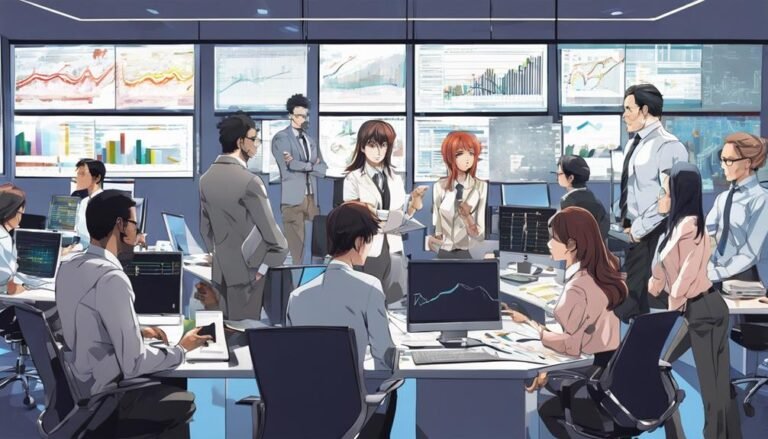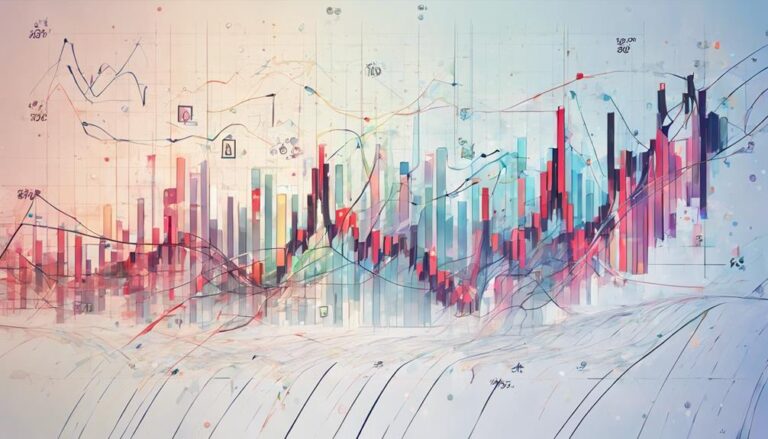Global Economic Trends Explained: What You Need to Know
In today's interconnected world, staying informed about global economic trends is essential for individuals and businesses alike.
From the impact of trade policies to the complexities of emerging market dynamics, various factors shape the global economic landscape.
Understanding these trends provides valuable insights for making informed decisions in an ever-changing environment.
By exploring the intricacies of these trends, one can navigate the complexities of the global economy with a clearer perspective.
Key Takeaways
- Economic indicators like GDP growth, inflation rates, and trade balances offer insights into global economic performance.
- Trade policies impact competitiveness, market stability, and supply chain dynamics.
- Technology disruption and AI adoption revolutionize industries, enhancing decision-making and efficiency.
- Emerging markets and trade alliances drive economic growth, influencing trade balances and market dynamics.
Understanding the Basics
What are the fundamental principles that underpin global economic trends? Understanding trends in the global economy requires a thorough analysis of various economic indicators. Economic indicators are statistics about economic activities that provide insights into the health of an economy. These indicators include GDP growth rates, inflation rates, unemployment rates, consumer spending, and trade balances, among others. By examining these indicators, economists and policymakers can assess the current state of the economy and predict future trends.
GDP growth rates are one of the most important economic indicators as they measure the overall economic performance of a country. Inflation rates indicate the rate at which prices are rising, providing insight into the purchasing power of consumers. Unemployment rates reflect the health of the labor market, while consumer spending drives economic growth. Trade balances show the relationship between a country's exports and imports, impacting its overall economic health. By analyzing these economic indicators, stakeholders can better understand global economic trends and make informed decisions.
Impact of Trade Policies
Trade policies play an important role in shaping the economic landscape of nations by influencing international trade dynamics and market behaviors. These policies can have significant impacts on economies worldwide, with effects ranging from tariff impositions to import restrictions.
- Tariff effects: Tariffs, which are taxes imposed on imported goods and services, can lead to higher prices for consumers, reduced competitiveness for domestic industries, and potential trade wars between nations.
- Import restrictions: Policies restricting the quantity or types of goods that can be imported can protect domestic industries but may also limit consumer choices and increase prices.
- Market volatility: Sudden changes in trade policies can lead to market uncertainty, affecting investor confidence and overall economic stability.
- Global supply chains: Trade policies influence the structure of global supply chains, impacting production costs, efficiency, and geographic distribution of manufacturing facilities.
Technology Disruption
Technology disruption has become a defining force in global economies. The impact of AI and digital transformation is revolutionizing industries. The adoption of these technologies has brought about significant benefits. These include increased efficiency, improved decision-making processes, and enhanced customer experiences.
As businesses continue to integrate these advancements, the landscape of economic activities is undergoing a profound transformation. This transformation is shaping the future of work and productivity.
Impact of AI
In today's rapidly evolving global economy, the pervasive impact of Artificial Intelligence (AI) on various industries is becoming increasingly evident. AI advancements and automation are reshaping traditional business models and processes, leading to increased efficiency and productivity.
Here are four key ways in which AI is influencing the economic landscape:
- Enhanced Decision-Making: AI's ability to analyze vast amounts of data in real-time is revolutionizing decision-making processes.
- Increased Automation: Tasks that were once performed by humans are now being automated, leading to cost savings and improved accuracy.
- Predictive Analytics: AI algorithms are enabling businesses to forecast trends and customer behavior with greater accuracy.
- Personalized Experiences: AI is facilitating the delivery of personalized products and services to customers based on their preferences and behaviors.
Digital Transformation Benefits
The current era of digital transformation is ushering in a paradigm shift in the way businesses operate and interact with customers, revolutionizing traditional practices and fostering innovation. Embracing digital transformation offers companies a competitive advantage by enabling them to adapt quickly to market changes and meet customer expectations efficiently. Strategic investments in technology help streamline processes, enhance productivity, and drive growth. By leveraging data analytics and automation, organizations can make data-driven decisions that optimize operations and enhance customer experiences. Digital transformation empowers businesses to stay agile and responsive in a rapidly evolving landscape, enabling them to outperform competitors and thrive in the digital age.
| Benefits of Digital Transformation | ||
|---|---|---|
| Competitive Advantage | Strategic Investments | Enhanced Customer Experiences |
Emerging Market Dynamics
Emerging market dynamics are influenced by the growth trajectories of BRICS nations, including China and India, which play significant roles in the global economy.
Currency fluctuations further impact these markets, affecting trade balances and investor confidence.
The formation of trade alliances among emerging economies can create both opportunities and challenges as these nations navigate the complexities of global commerce.
Growth in BRICS
Experiencing a notable surge in economic output and trade activities, the BRICS nations are shaping the global economic landscape with their dynamic growth patterns.
- GDP Expansion: BRICS countries have shown consistent GDP growth rates above the global average, driving economic development within their borders.
- Trade Partnerships: Increased intra-BRICS trade relationships have fostered economic cooperation and boosted international trade volumes.
- Infrastructure Investments: BRICS nations are investing heavily in infrastructure projects, enhancing connectivity and facilitating economic growth.
- Market Influence: The collective economic weight of BRICS countries is influencing global markets, attracting investments and reshaping global supply chains.
This robust growth in BRICS economies underscores their significance in the broader context of global economic development.
Currency Fluctuations Impact
Amidst the dynamic growth patterns of the BRICS nations, the impact of currency fluctuations on emerging markets' dynamics is becoming increasingly significant in the global economic landscape. Exchange rate fluctuations and market volatility play a vital role in shaping the economic conditions of these nations.
Sudden currency devaluation can have severe economic impacts, leading to decreased purchasing power, inflationary pressures, and reduced investor confidence. Countries with strong export industries may benefit from a weaker domestic currency, boosting their competitiveness in the global market. However, excessive volatility can also create uncertainty, making it difficult for businesses to plan and invest for the long term.
Understanding and managing the effects of currency fluctuations are essential for sustaining growth and stability in emerging markets.
Trade Alliances Formation
The formation of trade alliances among emerging markets is a strategic mechanism that fosters economic cooperation and enhances global competitiveness. Regional integration and trade agreements play pivotal roles in shaping these alliances. Here are four key aspects to ponder upon:
- Tariff Reduction: Trade alliances often involve agreements to diminish tariffs among member countries, promoting increased trade flows.
- Market Access: By joining forces, emerging markets can gain improved access to each other's markets, creating new opportunities for businesses.
- Policy Coordination: Alignment of policies within trade alliances helps in streamlining regulations and standards, facilitating smoother trade processes.
- Economic Diversification: Collaborative efforts through trade alliances enable participating countries to diversify their economies and reduce dependence on a single market.
Inflation and Interest Rates
An analysis of current economic indicators reveals a significant correlation between inflation rates and changes in interest rates. Inflation, a key economic indicator, impacts interest rates through monetary policy implications. Central banks closely monitor inflation levels and adjust interest rates accordingly to control the money supply and stabilize prices. When inflation rises above target levels, central banks may raise interest rates to curb excessive spending and prevent the economy from overheating. Conversely, in times of low inflation or deflation, central banks may lower interest rates to stimulate borrowing and spending to boost economic growth.
Market dynamics play a pivotal role in how changes in interest rates affect inflation and vice versa. Investors closely watch central bank strategies and adjust their portfolios based on expected interest rate movements. Anticipated changes in interest rates can impact bond yields, stock prices, and exchange rates, influencing inflation expectations. Understanding these interconnections between inflation, interest rates, and market dynamics is essential for policymakers and investors to make informed decisions in a complex global economic environment.
Global Supply Chain Shifts
Global Supply Chain Shifts have become a focal point in global economic discussions due to recent supply chain disruptions and reshoring initiatives.
The pandemic exposed vulnerabilities in the existing supply chain models, prompting companies to reassess their strategies.
As a result, many are now considering reshoring production to mitigate risks and increase supply chain resilience.
Supply Chain Disruptions
Amidst the evolving landscape of international commerce, supply chain disruptions have emerged as a critical factor influencing global economic trends.
- Supply Chain Resilience: Companies are reevaluating their supply chain strategies to enhance flexibility and minimize vulnerabilities.
- Challenges in Global Logistics: Delays in transportation and shipping have become more common, impacting the timely movement of goods.
- Disruptions in Production: Factory closures and labor shortages in key manufacturing regions have disrupted production schedules.
- Inventory Management Issues: Fluctuating demand patterns and supply chain interruptions have made inventory management more complex and challenging.
These disruptions highlight the need for businesses to prioritize supply chain resilience and agility to navigate the uncertainties in the global market.
Reshoring Initiatives
The reshoring initiatives in global supply chains reflect a strategic shift towards localized production. Companies are increasingly considering the benefits of reshoring, such as reduced transportation costs, improved quality control, and quicker response times to market demands.
By bringing production closer to home, businesses can enhance supply chain resilience and mitigate risks associated with global disruptions. Local production also fosters job creation and supports domestic economies, contributing to long-term sustainability.
While reshoring may initially entail higher production costs, the overall benefits regarding reliability and agility often outweigh these expenses. As companies reassess their supply chain strategies due to recent global challenges, reshoring initiatives are gaining traction as a viable solution to enhance operational efficiency and competitiveness.
Sustainability and ESG Factors
In the domain of economic analysis and investment strategies, the integration of sustainability and ESG (Environmental, Social, and Governance) factors has become increasingly imperative for informed decision-making and risk management. When considering sustainability and ESG factors, several key aspects come into play:
- Green Investing: This involves directing capital towards companies or projects that support the shift to a more sustainable economy, often focusing on renewable energy, clean technology, and energy efficiency.
- Corporate Responsibility: Companies are being evaluated not only on their financial performance but also on their social and environmental practices, including issues like diversity, labor standards, and community engagement.
- Sustainable Finance: The emphasis here is on investments that consider long-term environmental and social implications, promoting financial stability and resilience.
- Environmental Impact: Evaluating how business activities affect the environment is vital for ensuring sustainable practices and minimizing negative consequences for ecosystems and natural resources.
Integrating these factors into decision-making processes can lead to more holistic and responsible investment strategies, aligning financial goals with broader societal and environmental objectives.
Currency Fluctuations
Analyzing currency fluctuations is essential for understanding the dynamic interplay of global economic forces and their impact on trade and investment outcomes. Exchange rates play a critical role in determining the competitiveness of a country's exports and imports. When a currency depreciates, it can make a country's exports more attractive to foreign buyers while making imports more expensive for domestic consumers. On the other hand, a strengthening currency can have the opposite effect.
Market volatility, influenced by factors such as economic indicators, geopolitical events, and central bank policies, can lead to sudden and significant fluctuations in exchange rates. These fluctuations pose both risks and opportunities for businesses engaged in international trade. Companies that engage in hedging strategies to manage currency risk can protect their profit margins from adverse exchange rate movements.
Understanding and monitoring currency fluctuations is essential for investors seeking to make informed decisions in an increasingly interconnected global economy.
Geopolitical Risks
Currency fluctuations, influenced by various factors, are intricately tied to geopolitical risks that can greatly impact global economic stability and investment strategies. Political instability and economic sanctions are key contributors to these risks.
Here are four essential points to contemplate:
- Political Instability: Unforeseen political events such as coups, civil unrest, or abrupt changes in leadership can lead to uncertainty in markets, causing fluctuations in currency values.
- Economic Sanctions: When countries impose sanctions on one another, it can disrupt trade flows and financial transactions, directly affecting exchange rates and investor confidence.
- Global Trade Agreements: Geopolitical tensions arising from trade negotiations or disputes between major economies can create volatility in currency markets, impacting international investments.
- Regional Conflicts: Military conflicts or geopolitical tensions in specific regions can trigger risk aversion among investors, leading to capital outflows from affected areas and affecting currency valuations globally.
Understanding and monitoring these geopolitical risks are essential for investors and policymakers to make informed decisions and mitigate potential economic repercussions.
Future Economic Outlook
Emerging from the current global economic landscape, the future economic outlook presents a myriad of challenges and opportunities for policymakers and investors alike. Economic forecast models are essential tools in predicting the direction of economies, but they are subject to uncertainties due to various factors such as geopolitical tensions, trade policies, and technological advancements. Understanding market trends is critical for making informed decisions that can mitigate risks and capitalize on emerging opportunities.
In the coming years, the economic forecast indicates a moderate growth trajectory for many regions, albeit with some disparities among developed and emerging economies. Market trends suggest a shift towards digitalization, sustainability, and resilience as key drivers of economic activity. Policymakers are likely to focus on implementing measures that support sustainable growth, innovation, and inclusivity while addressing challenges such as income inequality and climate change.
As investors navigate the future economic landscape, staying attuned to changing market trends and adapting strategies accordingly will be paramount to achieving long-term success in a dynamic and interconnected global economy.
Conclusion
In the turbulent seas of global economics, trends ebb and flow like the tides, influenced by trade winds, technological currents, and market dynamics.
Like a compass in a storm, understanding these factors can steer businesses towards success or shipwreck.
As the world navigates through currency fluctuations, geopolitical risks, and sustainability concerns, the future economic outlook remains uncertain yet full of potential opportunities for those who can ride the waves with strategic foresight.







